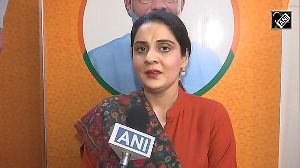A prominently displayed plaque at the entrance of Reliance Industries' office in New Delhi spells out Mukesh Ambani's vision for Reliance Infocomm. But the telecom company that has always been identified as Mukesh's baby was made over to younger brother Anil in the settlement worked out last month.
Except that Anil Ambani hasn't been involved with the running of Infocomm; it's a company that's been in trouble with the law; and its biggest, so far unquestioning source of funds -- RIL -- is no longer available. Add to this an inheritance that includes customer dissatisfaction, a downmarket image and a technology that's not being accepted as well it could be, and Ambani's clearly got his work cut out for him.
The Strategist discussed the issues on hand with Infocomm executives, competitors and telecom industry experts. Here's their analysis of trouble areas and possible ways out.
Tech trouble
First, the good news. Infocomm is the second largest player in the mobile telephony arena: its 20 per cent share of the 52-million subscriber market is just one percentage point behind Bharti. It has a nation-wide presence, a robust infrastructure -- an 80,000-km optical fibre cable network that supports voice, data and video -- and a pan-India wireless network based on the latest CDMA technology.
"We aim to be the leaders in the digital value chain. This means we will be in the mobile telephony, long-distance, broadband, home, media and entertainment space," says the spokesman for Reliance Infocomm.
But, at Rs 5,387 crore (Rs 53.87 billion), its revenue is 33 per cent lower than that of Bharti, which also has a pan-Indian presence, operates on the GSM platform and has just 0.5 million more subscribers than Infocomm (11 million).
What explains this gap in revenues? One reason is that Infocomm hasn't got enough high-end subscribers. According to a recent study by the Telecom Regulatory Authority of India, Infocomm's average revenue per user is Rs 258 a month, compared to GSM players like Bharti, Hutch, and Idea, whose average monthly ARPU is Rs 400 (for some service providers such as Hutch, the blended ARPU can be as high as Rs 750 a month). Infocomm can blame its late entry into mobile services for that.
Arpita Pal Agrawal, a telecom industry consultant with PricewaterhouseCoopers, explains a little more. "With any technology, first the most paying get on to the networks. That gave Bharti an early-mover advantage."
Gradually, as tariffs came down and handset prices dropped, Bharti tapped the mass market too, with its strong brand positioning and network strength. Which means that by the time Reliance announced its CDMA services in December 2002, most high-end customers had already signed on with other service providers. Meanwhile, points out telecom industry expert Mahesh Uppal, "Reliance was left with the dregs."
And it's not going to be easy to get the big spenders to switch to Infocomm (remember, price is no longer an issue: mobile telephone rates are now more or less the same across service providers).
The issue here is technical: the CDMA technology adopted by Infocomm does not support international roaming services on different networks. It didn't help that, until some time ago, Infocomm subscribers could not change their handsets at will -- that was also a deterrent to several potential customers.
Perhaps the way out lies in concentrating on data service-based revenue, given that voice is becoming increasingly commoditised. One option is the data services plan that Mukesh Ambani chalked out in 2002, when he had indicated that voice telephony would account for not more than 25 to 30 per cent of Infocomm's total revenue. The numbers point to the sense in that plan.
Trai has forecast that by 2010, the number of Internet subscriptions in India will increase to 40 million, from 6 million currently. Of this, broadband will account for 9 million subscriptions in 2007 and 20 million by 2010.
Infocomm has an edge here: when it comes to data, CDMA technology has proven superior to GSM -- its spectrum is more reliable, making functions like broadband, video conferencing, gaming, DTH, V-Sat and so on, more efficient.
Value-added services could be another money spinner. Over 10 per cent of the mobile service revenue of GSM service providers comes from add-ons such as missed call status, caller ring-back tones, ringtones, wallpapers, text and multimedia messages, and so on.
Recent research by brokerage and research firm SSKI places the VAS market at nearly Rs 350 crore (Rs 3.5 billion) -- expected to grow to Rs 3,800 crore (Rs 38 billion) by 2010 -- of which more than a quarter is accounted for by CRBTs. Airtel's "Hello Tunes" illustrates that perfectly. The CRBT service was introduced a year ago -- it now offers 10,000 songs in 18 languages and gets 2 million downloads every month.
Uppal, too, advocates VAS as a viable option for Infocomm, but adds a rider: "These features are fast picked up by competitors." The key is constant innovation -- after Hello Tunes, Airtel moved on quickly to launch a stock ticker, sudoku puzzles and games based on the latest movies. But innovation may be a test for Ambani. " Reliance has been a hard-core product company with limited experience of running services," agrees Uppal.
Billing bungles
I am a Reliance customer in Delhi and the NCR. I have not received any bills since October 7. Is this a problem only with me or with other Reliance subscribers, too? (January 16, 2004).
My unbilled usage starts from Rs 1,600.60 every month. My monthly average bill is around Rs 900. Right after my bill is generated, I get a call that my usage is high (my credit limit is Rs 1,500). The executives just don't accept my problem since they say they use an "error-free world-class billing system" (March 18, 2005).
Complaints posted on RIMweb.com
Building up its strengths region by region may also help Infocomm overcome its troubles with faulty billing and customer complaints. A company insider attributes billing glitches -- a perennial grouse against Infocomm -- to faulty software and weak processes for database management. Anil Nayar, director, Bharti Tele-Ventures Ltd, points to the possibility of human error, too. "There can be lapses while processing the bill."
Could outsourcing the billing function be the solution? That would free up Infocomm resources that could be deployed on customer care, feedback and brand building. Bharti already outsources roughly 70 per cent of its call centre operations and, in March 2004, it contracted out its entire IT functions (including billing) to IBM.
Nayar says that has worked well. "When you are growing very fast, there is a tendency to miss out on certain areas, which can pull you down," he says.
Meanwhile, Infocomm has been busy reaching out to customers. Its retail and customer service outlets -- the Reliance Webworld -- has given way to a sleeker, smaller avatar, the Reliance Webworld Expressway.
Compared to the 240 Webworlds that were set up over two years, since April this year more than 1,000 WWEs have already come up. And according to Trai's recent report on the telecom industry, for the first quarter of FY05, Infocomm has a 100 per cent response rate in areas such as fault incidence and repair; its average call rate success (within the licensee territory) is 99.05 per cent.
Brand building
This is perhaps the biggest task ahead of Infocomm. For starters, Anil and Infocomm now no longer have the backing of RIL. Infocomm has also had a couple of brushes with the law, which haven't helped its reputation any.
But perhaps the biggest hurdle for the company will be to change the image perception of its mobile service. Points out an industry observer, "Reliance decided to offer cellular phones services at the cost of a post card. Consequently, the poor man's phone perception has stuck to CDMA."
Quickbite: Vox Populi
Market trends indicate that the next battleground for telecom companies will be the non-voice data services segment. According to research firm IDC India, the non-voice market (SMS and ringtones among others) was Rs 695 crore (Rs 6.95 billion) in 2004 -- based on the current mobile turnover of around Rs 22,000 crore (Rs 220 billion), that's around 3.15 per cent of the total business.
By the end of the decade, estimates IDC, the value-added services market -- ringtones, wallpapers, caller ring-back tones and multimedia messaging, among others (that is, the non-SMS part of the non-voice market) -- will grow from a mere Rs 191 crore (Rs 1.91 billion) in 2004 to around Rs 2,300 crore (Rs 23 billion). That's a compound annual growth rate of over 65 per cent.
Consider Korea, one of the world's fastest data services markets. IDC has forecast the mobile market there to soar by 30 per cent in 2005 to £1.34 billion. In contrast, the voice market is only expected to grow by 3.4 per cent.
The key drivers for the increase in mobile data revenues will be the growing number of video services and an increasing number of mobile banking users. In particular, video telephony calls are predicted to make a big impact on the Korean mobile data market as the new W-CDMA networks take off.






 © 2025
© 2025